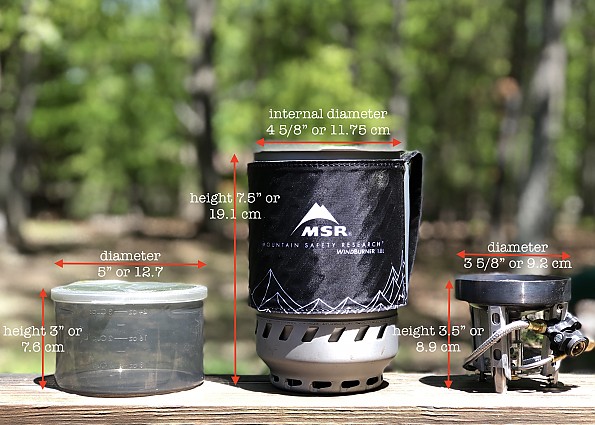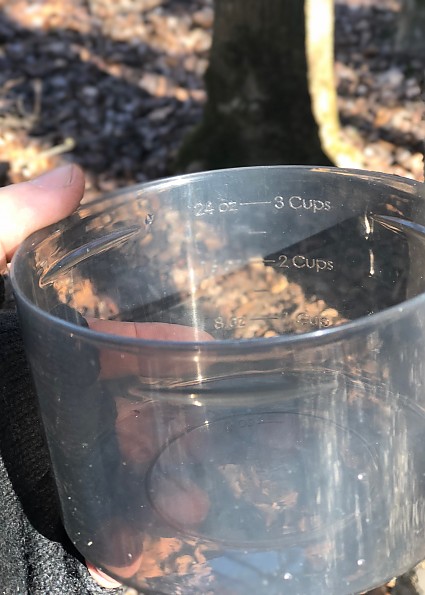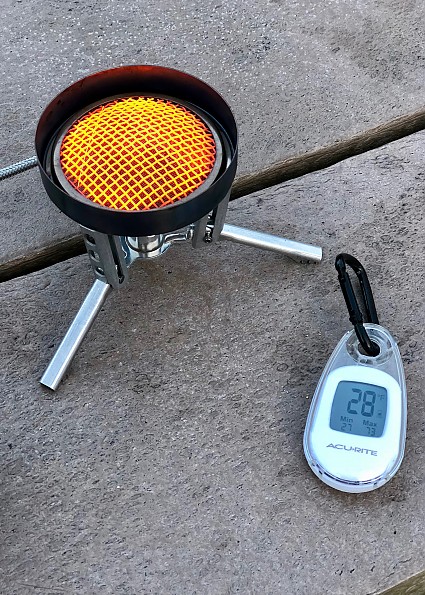MSR WindBurner Duo Stove System
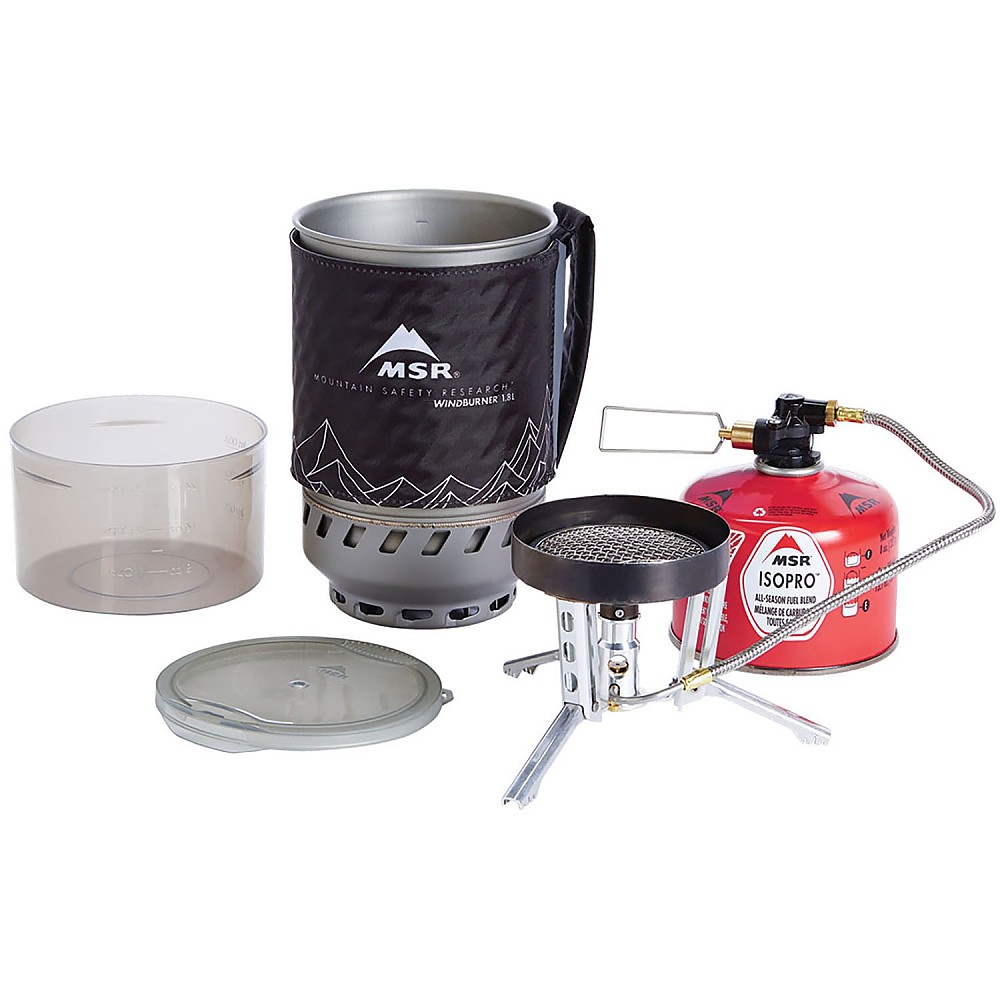
While pricy and a bit more bulky and heavy than some stove systems, the WindBurner Duo System with remote canister is a stable, weather-resistant stove for fast, easy use, even in adverse conditions with options to expand one's cooking range with the addition of other modular pots and pans.
Pros
- Very efficient
- Very weather-resistant
- Very high quality
- Convenient, self-contained system
- Option for add-on, modular components
Cons
- Pricy
- Pot and other accessories only work with this system
- More bulky and heavy than some stove systems
Note: this review is divided into the following sections. Scroll down to locate any section of interest.
- Video Overview
- Features & Dimensions
- Build
- The Pressure Regulator
- Operation
- Stowage
- Field Testing
- Performance: General Observations
- Performance Claims
- Efficiency, Temperature, and Environmental Conditions
- Rain & Snow
- A Word on Fuels
- Modularity
- Conclusions
Video Overview
Features & Dimensions
The MSR WindBurner Duo is a 2-person stove system that offers remote canister stability and safety with an efficient and fast radiant burner. Within MSR’s stove line-up, the WindBurner shares its radiant burner design with the more powerful Reactor stove (which MSR says is designed for snow-melting alpinists), but offers “a truly personal unit” with features “tailored to meet the needs of one or two travelers heading into the backcountry, or simply camping in the frontcountry—and anyone who’s trying to cook a hot meal in places where real weather can happen.”
The WindBurner System utilizes convective and radiant heat efficiently while its radiant burner design uses 100% primary air, mixing the fuel and oxygen within the well protected confines of the burner and thus providing admirable wind-resistance for its flame.
The Duo kit includes:
- a WindBurner radiant burner
- a 1.8L hard-anodized aluminum pot
- a .85L BPA-free bowl with lid
- a small square of PackTowl
The pot features an integrated cozy and handle as well as a heat exchanger to increase efficiency. The lid features a sipping opening as well as a straining option. The small square of PackTowl provides a barrier between fuel canister and pot bottom when stowed.
The illustration below shows the components of the Duo system as well as their diameters and heights.
The components’ weights break down as follows:
- bowl 1.9 oz/ 54 g lid .7 oz/ 20 g
- radiant burner 8.68 oz/ 246 g
- hard-anodized pot 10.5 oz/ 298 g
- Total Weight: 21.8 oz/ 618 g, or 1.36 lbs/ .62 kg
Build
The WindBurner is a solid piece of kit. The legs are machined aluminum, cleverly designed to be slipped, spring-loaded, inside the brackets supporting the burner. The flame adjuster is sensitive to a light touch, and its generous size facilitates careful adjustments while cooking. The pressure regulator assembly is hefty and solid-feeling in the hand with brass fittings used throughout. 

The hose is wrapped in a sheath of flexible, stainless steel mesh, and each end is secured within a shroud of brass to reinforce any potential weak spots. A curving arc of stainless steel tubing feeds the fuel from the hose into the mixer tube. 
The burner head itself is a seamless steel rim with heavy outer steel mesh protecting a finer inner steel mesh. Overall, the stove impresses one with a sense of quality materials, thoughtful design, and careful execution.
The solidity carries over to the pot, too. The nylon fabric and plastic of the cozy feel rugged. The pot itself features precision welding that joins pieces of the heat exchanger to one another as well as to the pot itself. These welds appear to have been accomplished with thousands of tiny touches to achieve adherence to the hard-anodized coating without damaging the soft aluminum beneath.
Bowl and lid possess nice details: measurements within the bowl aid in apportioning water for rehydrating meals, and the strainer/sipping lid serves dual roles as both pot or strainer and as bowl lid.
The Pressure Regulator
MSR claims the pressure regulator, located with the stove's valve, is a key piece of this stove’s design and an element included to allow the stove to work better and longer at colder temperatures.
In a post in MSR’s blog, the MSR team presents their claims as to the advantages of a pressure regulator:
“When the temperature drops to 50°F, the pressure in the canister drops to 30 psi. As you run your stove, your canister cools further, easily dropping to 40°F and 22 psi. As it turns out, on that cool fall morning your stove may actually be putting out less than 60% of its rating. In contrast, MSR’s WindBurner and Reactor stoves are designed to run at full output at only 15 psi. The regulator ensures that the stove only receives that precise pressure regardless of the real pressure inside the canister (until it finally drops below 15). It’s only when your canister is nearly empty or the conditions are extremely cold that the pressure will finally drop below the limit of the pressure regulator and you’ll notice it in performance.”
This was not a comparative stove test, and I do not have the laboratory equipment to scientifically assess MSR’s claim, but I can say this: I used the stove successfully in freezing conditions and below amid freezing rain and snow.
However, as I also used a variety of fuels (some of which, frankly, were not the best blends for colder temperatures), and as I also used a range of canisters from full to nearly empty (which theoretically shouldn't matter as much with a pressure regulator), and as I used these in a variety of weather conditions, I did see more fluctuation in performance than MSR’s claims might initially lead one to believe.
The value of pressure regulators on stoves used in cold temps is, however, commonly asserted: for those interested, “Hikin’ Jim,” a stove aficionado, offers his take on the cold weather advantages of pressure regulator stoves here.
Operation
Operating the stove is simple enough that it can be reduced to pictures included in MSR’s Instruction Manual.
Having selected an area free of combustible materials, one first extends the retractable legs from the burner stand, which results in a stable 6.5 in/ 16.5 cm base for the burner and any related cooking implements. Having made certain the flame adjuster is off, one next screws the fuel canister onto the regulator valve assembly. This places the fuel canister about 8 in/22 cm from the burner, a safe distance from the flame.
With the flame adjuster open to allow the flow of fuel, one holds a lighter or lit match to the burner screen to light the stove. I also used sparks from a ferrocerium rod to light the stove without issue, though I was careful as to where I directed the sparks: the manual warns that one should never attempt to light the stove through the mixer tube.
A glowing indicator wire indicates that the burner is in use, a useful feature I came to appreciate very much during testing. The flame adjuster closes off the fuel once cooking is finished. 
Disassembly after use is as simple as one might expect: just invert the order of operations, unscrewing the canister and retracting the legs after the stove has cooled for at least five minutes.
Stowage
The WindBurner Stove System offers convenience in terms of stowing its components between uses. The design allows all components to be stored in and around the pot: the interior of the pot can hold an 8 oz. fuel canister as well as the radiant burner; the lid secures both within. The bowl fits around the bottom of the pot, effectively containing the system in a 5 in./ 12.7 cm diameter cylinder that stands just shy of 8 in./ 20.3 cm. I found this size reasonable when I was cooking for my kids and me, and I appreciated the packability of the system as a whole.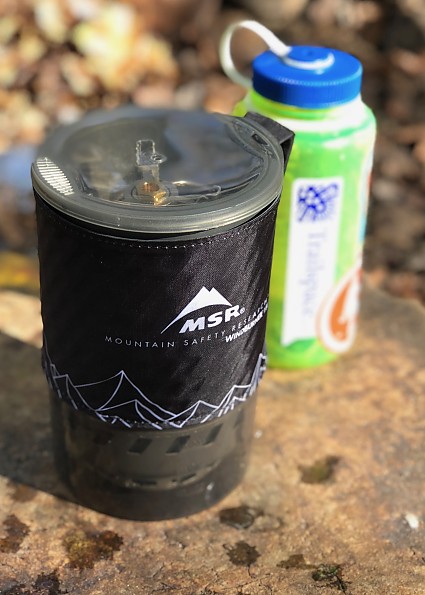
Field Testing
I tested the Duo system over a period of nearly 5 months in conditions ranging from sunny and temperate weather to rain, freezing rain, and snow. I used it in balmy temperatures as well as below freezing and at altitudes between 800-2900 ft/ 244-884 m. I used it at home, on car camping trips, and on backpacking trips. I did not use a windscreen with this stove during testing.
Performance: General Observations
Let me start with the simplest things first: the bowl works perfectly well, whether being used as a measuring cup or as a serving vessel. It is easy to clean, firm in the hand, and readily stowed on the bottom of the pot.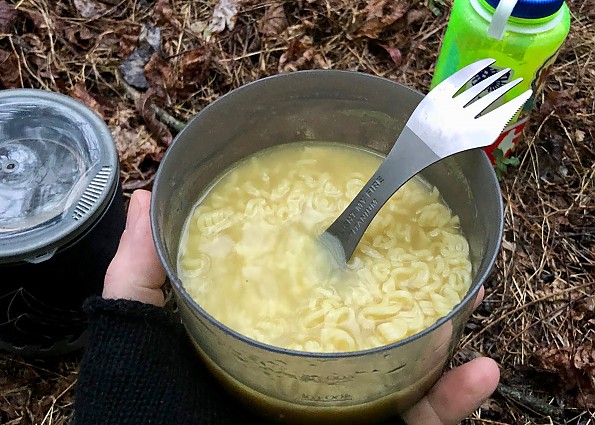 The lid also functions well, although heat deformed it slightly from repeated use. Nevertheless, it still snaps tightly onto the pot or bowl, allowing one to boil water more rapidly and efficiently or strain off excess water from whatever one might have cooked in the pot.
The lid also functions well, although heat deformed it slightly from repeated use. Nevertheless, it still snaps tightly onto the pot or bowl, allowing one to boil water more rapidly and efficiently or strain off excess water from whatever one might have cooked in the pot.
In general, the WindBurner ignites with a minor flare of the ignition source’s flame. A subsequent glow steals across the indicator wire, at which point the burner is good to go.
 A somewhat muted, rushing roar signals the flame adjuster is wide open, a sound that registered (unscientifically) between 70.9 and 74 dB on a phone app. That’s about the level of normal conversation.
A somewhat muted, rushing roar signals the flame adjuster is wide open, a sound that registered (unscientifically) between 70.9 and 74 dB on a phone app. That’s about the level of normal conversation. In a wide range of conditions, the WindBurner quickly heats water or food. I have used this with both the Duo pot and the WindBurner Ceramic Skillet. I’ve boiled water, cooked noodles, heated soup, and cooked a whole range of foods using the skillet (please see the WindBurner Ceramic Skillet review for more details). I appreciated the speed and efficiency of this system, especially when I was hungry, cold, or tired. The WindBurner Duo delivers with little need for thought or effort.
In a wide range of conditions, the WindBurner quickly heats water or food. I have used this with both the Duo pot and the WindBurner Ceramic Skillet. I’ve boiled water, cooked noodles, heated soup, and cooked a whole range of foods using the skillet (please see the WindBurner Ceramic Skillet review for more details). I appreciated the speed and efficiency of this system, especially when I was hungry, cold, or tired. The WindBurner Duo delivers with little need for thought or effort.
With a little use one grows acclimated to the sensitivity of the flame adjuster, and with a little more experience it is possible to simmer food in a skillet or in the pot. This opens the door to a variety of culinary options beyond mere boil-and-rehydrate, though the WindBurner excels at that, too.
The WindBurner is a satisfyingly stable stove, holding cooking vessels on its burner just 3.75 in/ 9.5 cm off of whatever surface it is resting on. The burner also includes a ring in which pots or pans seat themselves securely, a feature that ingeniously blocks the wind while also preventing pans from sliding around on the burner. This means that the stove system feels rock solid even with more than a liter of water in its tall pot or with the skillet on top of it. The remote canister design provides much stability and little potential for spilling disasters that some, taller more top-heavy systems may permit.
Some “sit-on-top” stoves may require a close-fitting windscreen to shield their flames. Given certain conditions such as prolonged use and a wide skillet or pot atop the stove, these canisters can overheat and one occasionally hears tales of them exploding. The WindBurner completely circumvents these potential issues by having a more or less windproof design and by having a remote canister. Extended skillet use need not provoke fears of overheating canisters.
The tradeoff is weight: this stove is certainly heavier than some sit-on-top options—I have a sit-on-top stove that weighs a mere .88 oz/ 25 g, much less than the WindBurner’s 8.68 oz/ 246 g burner. That stove, however, requires a separate windscreen, and it is also not as efficient as the WindBurner.
A more direct competitor is the Jetboil Sumo 1.8L system; it weighs a listed 16 oz/ 453 g to the Duo's 21.8 oz/ 618 g.
Performance Claims
MSR packaging claims boils times “up to 4x faster than competitor’s stoves in windy & colder conditions [8 mph/32˚F], and promotes this stove’s windproofness and “constant performance even in colder temps” as a result of its pressure regulator. Further, MSR labels the Duo system as “ultra-efficient” and promotes it as being a modular part of the WindBurner cookware and “a range of cooking styles.” The packaging further cites 4:27 minute boil time per liter for the Duo.
Again, as this was not a comparative field test, I did not attempt to use the WindBurner in head-to-head tests with other stove systems, so I will not address this claim.
Windproofness
I conducted all tests without benefit of any windscreen, allowing the WindBurner’s design to be the only buffer against the wind. It is the nature of the design that wind is effectively held at bay. During testing I experienced conditions with wind gusts reaching over 20 mph/ 32 kph. The burner grew louder during these swirling gusts, but it stayed lit. Indeed, it is a testament to the stove’s design that I ceased to think about the wind after a while, considering it a nuisance on only when windy conditions snuffed out matches or lighters when I was trying to light the burner initially.
Efficiency, Temperature, and Environmental Conditions
Unlike the windless, 70˚F test conditions of a laboratory, Mother Nature does not offer standardized test conditions that might deliver consistency in terms of performance, so I’m framing my observations of the WindBurner based on trends instead.
Note: since I made observations over a range of uses with different fuels in different conditions, it is important to keep in mind that some factors of stove performance may be attributable to testing conditions and fuel blend variations as opposed to stove design or features.
Here are the trends, then, that I observed while testing the MSR WindBurner Duo System:
- In warmer conditions, the WindBurner’s 7000 BTU/hr burner can meet or even exceed MSR’s claimed 4:27 per liter boil time—I had one test yield a rolling boil at 4:25 minutes in 70˚F/ 21˚C temperature. Boil times for a liter of water right around 4:30 are routine in temperate conditions, usually a few seconds under 4:30, so MSR’s claim seems fair if one recalls it reflects optimal conditions. I should note that boil time tests were undertaken at maximum stove output levels.
- At colder temperatures, other factors such as warmth of canister, type of fuel blend, and external temperature may slow a canister stove’s efficiency and boil time performance. To be fair, MSR insists one should use MSR fuel, and I didn’t always do this (see “A Word on Fuels,” below). Nevertheless, MSR’s pressure regulator does appear to help extend stove function in cold weather operation. I continued to cook and boil water as temperatures dropped, in rain, sleet, and snow. It generally just took longer than 4:30 to boil a liter of water while influenced by factors causing of less than operation.
- Because of factors which may affect stove efficiency, the amount of fuel used by the WindBurner to boil a liter of water varies, too. Among tests when I weighed canisters before and after, .35-.42 oz/10-12 g of fuel was used to boil a liter of water. To give a sense of the range one might encounter, the WindBurner used .63 oz/ 18g of fuel when I boiled a liter of water in 32˚F/ 0˚C temps during a snowstorm.
Mother Nature afforded me with a range of temperatures during my testing period. In many tests with warm fuel canisters, I had success across fuels in using the WindBurner to heat water and cook food—at 29˚F, at 31.7˚, at 32˚, at 54˚, again at 32˚, at 57˚, at 52˚, at 72˚, at 81˚and so on, each on different days, in different weather conditions. The WindBurner Duo System functioned well during all of these tests, though on occasion it was a bit slower to reach full burn based on the variables mentioned previously.
Rain and Snow
Obviously, it is possible to keep the stove burner out of the elements until one needs to use it. I did experiment with the burner in both rain and snow, though, allowing rain to wet the burner and snow to gather in it. In both conditions, after blowing out or brushing off excess moisture from the burner, I was able to use the stove without any problems. The 7000 BTU/hr output melted snow efficiently, too.

The mesh burner head does tend to try to hold onto snow in its crevices, but once clear of excess moisture, the burner’s heat quickly dries the element with a hiss of steam.
Note: I experienced snow flurries, not blizzard conditions, during testing. I would think that care should be exercised to keep the burner head free of snow build-up during blizzard conditions because freeing the cold mesh burner of snow in blizzard conditions would doubtless be an exercise in frustration.
While it is never a good idea to use stoves in tents, the comparatively flame-free nature of the radiant burner and the superior stability of this remote canister setup could moderate flammability risks associated with using a canister stove under a well-ventilated tarp or within an airy tent vestibule in inclement weather. It is worth noting—emphatically—that the deadly risks of carbon monoxide poisoning remains when any canister stove is used in a place without plentiful ventilation.
A Word on Fuels
MSR’s “Danger” card, which warns of indoor carbon monoxide poisoning, also directs one to “Use only MSR Premium Blend Canister Fuel, Vapor Pressure 80 isobutane/20 propane mix.” I did use MSR’s IsoPro All-Season Fuel Blend extensively during testing (it has the requisite 80/20 isobutane/propane blend). It performed beautifully with this stove.
However, reasoning that others might use whatever fuel they might be able to find most readily available, I also experimented with other fuels from my local outfitter and a big box store during my testing including Primus’ Power Gas 4 Season Mix, GSI’s All Season Fuel Mixture, and Coleman’s Performance Blended Fuel.
The stove is presumably optimized for use with MSR’s own fuel blends. While it is beyond the scope of this review to compare fuel performance with this stove, I will say that MSR’s fuel tended to perform best among these fuels at low temperatures, likely attributable to the higher concentration of isobutane and propane in MSR’s blend and these gases’ lower vaporization points (11˚F/-12˚C and -44˚F/-42˚C respectively).
Other fuel blends that I used included butane (n-butane), which vaporizes at 31˚F/-.5˚C. That can spell trouble in cold temps, as anyone who has tried to use a cold butane lighter in sub-freezing temps doubtless knows. For the curious, though, I’ve provided below the manufacturers’ blend information since these fuel blends were used during testing with this stove (the ordering is simply alphabetical):
- Coleman Performance Blended Fuel: 48-64/20-40/12-16 blend of isobutane/propane/n-butane
- GSI All Season Fuel Mixture: 70/25/5 blend of isobutane/propane/n-butane
- MSR IsoPro All-Season Fuel Blend: 80/20 blend of isobutane/propane
- Primus Power Gas 4 Season Mix: 25/25/50 blend of isobutane/propane/butane
Modularity
MSR touts the WindBurner stove as part of a larger modular system. Though I have only used the WindBurner with the Duo pot and the Ceramic Skillet, I did enjoy having the option of choosing to take a pan with me.

Modularity comes at fairly steep prices and an only-compatible-with-WindBurner caveat: the avid cook and WindBurner devotee could sink some serious money in getting a range of compatible cookware implements, but he or she would not be able to use them with other stove systems, unlike less expensive, more multi-stove friendly pieces of cookware. Other cookware systems and stoves can provide greater flexibility across systems at a lower cost, but if one has invested in a WindBurner, the modularity factor may be appealing.
Note: MSR noted in a recent Facebook Live video with some of its engineers that having the benefits of the radiant burner's technology requires WindBurner-only features, and further claimed that each pot's heat exchanger is "tuned" for the intended use of the pot, whether it be simmering, boiling, etc.
But returning to the point about the appeal of modularity, I could imagine that it would be nice to have both the Personal and the Duo pots so that one could adjust one’s stove system in small ways if one were traveling solo or with a companion. The larger Duo pot capacity might be welcome on a solo trip when melting snow for water, but at other times, its volume might be overkill and the Personal pot might better suit one’s needs. Such situational factors influencing use would likely apply to the other elements of the WindBurner system, too.
I suspect the modularity of this system would ultimately be most beneficial to those who travel in larger groups. I used the Ceramic Skillet to cook eggs and bacon for my kids on trips. While I didn’t test other pieces of the system, it is easy to picture a family or a Scout patrol, for instance, benefitting from the available 2.5L sauce pot or the 4.5L stock pot. Feeding more mouths with the system also might reduce some of the sting caused by the price tag of the accessory pieces. The stability of the WindBurner system might be welcome in scouting circles, too, as I recollect a frightening number of tipped pots on my own scout camping trips!
Ultimately, for those who have the money to spend on accessorizing this system and who are not concerned about having the lightest system possible, the WindBurner’s modularity may indeed be compelling.
Conclusions
The WindBurner Duo is an efficient stove system that works admirably well for the two-person use it is designed for. The radiant burner design and excellent wind protection make this an attractive option for those who want to quickly boil water for food or drink, even in colder and more adverse conditions than one might ordinarily consider taking a canister stove into.
Obviously, keeping the fuel canister warm is essential. With warm fuel canisters (especially with MSR’s isobutane/propane blend), the stove works well at colder temperatures. It works beautifully for three-season use and yes, even winter use—most of my testing happened during winter (albeit in a Southern U.S. winter). I would not, however, use this stove in place of a liquid fuel stove in bitterly cold conditions.
The WindBurner’s flame adjuster allows one to control the output of the burner with sufficient a wide variety of precision to simmer a sauce, produce golden brown pancakes, bring water to a lusty boil or reduce hard-packed snow to steaming water. This range of control is not likely to be used when merely boiling water, but it becomes especially advantageous when the WindBurner is used in conjunction with some of the modular accessories MSR offers. For some users, this versatility will be an attractive feature of the WindBurner System.
One potential drawback is that the stove is substantially more heavy and more bulky than most sit-on-top canister stove options, though in my experience it is also generally more efficient and stable than many such systems, too. The WindBurner offers superior performance, convenience, and efficiency while other systems may offer less performance, less weight, and less bulk.
Another potential drawback is the price: the Duo system has an MSRP of $179.95. Additional pots or pans for this modular system start at MSRP $69.95. A competitor mentioned previously, the Jetboil Sumo 1.8L system, has an MSRP of USD $139.95. The WindBurner Duo is an extremely well-made system that works reliably as it is intended to work.
Is it worth the cost? That’s a personal decision. MSR WindBurner Systems certainly command the high end of stove prices, but the company seems to enjoy a solid reputation for quality products that yield years of performance. I have yet to wear out my MSR PocketRocket despite years of use, and standing in front of an array of stoves at my local outfitter, a Triple-Crowner noticed me looking at them and volunteered that he always directs people toward the MSR WindBurner (in this case, the WindBurner Personal version on display).
Finally, the exclusivity of the pots and pans’ designs may be another drawback because it limits them to use with just the WindBurner System. I should note, though, that this design is also a significant key to the system’s efficiency and stability, too. For all of these potential drawbacks, I have docked the system a star in this review.
This remains, however, a superior product. If one seeks a high quality stove system for solo or two-person use, privileging efficiency, weather resistance, convenience, and modularity over other factors, the WindBurner Duo System with remote canister is an excellent system worth considering.
Source: received for testing via the Trailspace Review Corps
(Sample provided by MSR for testing and review)
I have the MSR Windburner 1.8L system, for two people instead of one.
Pros
- Larger than the .7 to 1.1 liter systems most carry
- Very fuel efficient
- Clean (never a problem with soot or deposits)
Cons
- Weight. There is a trade-off
- Size. If you are cooking for one it is too large.
- Price. The system will run around $160
My wife and I camp and backpack together. For car camping we have cast iron and a portable stove. But for backpacking, including five AT section hikes, that obviously won’t do.
We’ve tried the PocketRocket and similar things. With a titanium pot it is light, usually won’t blow out, and reasonably fuel efficient.
We have also used the one-liter pot size Windburner. But for two people when you are both hungry the fast meal is boiling enough water for both, toss in the meal and freeze dried chicken, and let it finish. The 1.7 is perfect for that.
Having used it side by side (we did a couple shakedown hikes where we carried both system) it is just faster and better and the one we ended up using.
In addition, the base will fit the matching pan for quesadillas and similar things (I’ve even met people using the Windburner pan on other bases for that). For day after day end of the day hot meals when it is raining or cold, it really makes a difference.
Background
Two out of five section hikes (smaller pot on same system for others) and other uses.
Source: bought it new
Price Paid: $159.95
Your Review
Where to Buy
You May Like
Specs
| Price |
MSRP: $179.95 Current Retail: $219.95-$229.95 Historic Range: $153.97-$229.95 Reviewers Paid: $159.95 |
| Fuel |
isobutane/propane, MSR IsoPro |
| Boil time for 1 L of water |
4.5 minutes |
| Water boiled per 1 oz of fuel |
2.3 liters |
| Dimensions |
5 x 5 x 8 in / 12.5 x 12.5 x 20.5 cm |
| Weight |
1 lb 5 oz / 0.60 kg |


